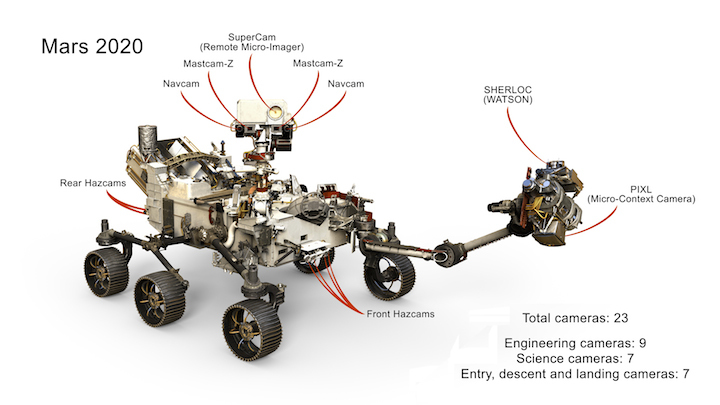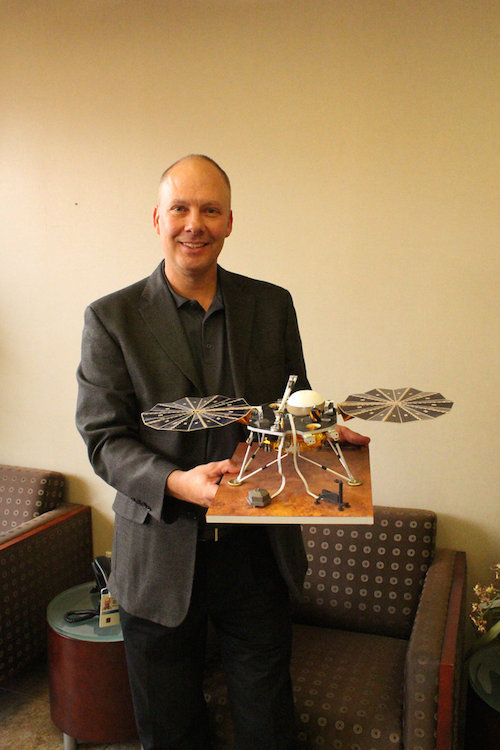NASA's Mars 2020 mission, which will look for signs of past life on Mars, will use smart methods originally developed to find the oldest life on Earth, according the mission's Deputy Project Scientist, Dr Ken Williford. The 2020 mission builds on the successes of prior rovers, to make coordinated measurements that could detect signs of ancient life - or biosignatures - in their original spatial context. These techniques, known as "spatially resolved biosignature analysis" derive from geochemical analysis of early life on Earth.
Speaking at the Goldschmidt conference in Paris where he is presenting the methods to be adopted, Dr Ken Williford (who is also Director of the Jet Propulsion Laboratory's Astrobiogeochemistry Laboratory) said:
"Previous missions to Mars have used a relatively broad brush - analyzing average chemistry over roughly the size of a postage stamp - to "follow the water" and seek ancient habitable environments. Mars 2020 takes the next natural step in its direct search for evidence of ancient microbial life, focusing measurements to the microbial scale and producing high-resolution maps over similarly postage stamp-sized analytical areas.
New scientific methods for searching for the most ancient evidence for life on Earth have led to a leap forward in capabilities for biosignature detection. Rather than using "bulk" geochemistry techniques that measure the average composition of a rock, Mars 2020 is developing new capabilities including X-ray fluorescence and Raman spectroscopy to map the elemental, mineral, and organic composition of rocks at high spatial resolution, with analytical spot sizes about the width of a human hair. Understanding the spatial distribution of chemical features preserved in ancient rocks is key to determining whether or not they were formed by life.
Beyond astrobiology, these new techniques enable exploration of the planet Mars at telescopic to microscopic scales - from a mountain to a grain of sand."
The instruments in development for Mars 2020 have roots in the search for the earliest signs of life on Earth, as well as life in extreme environments - deep underground, or in hydrothermal settings along ocean-floor ridges. When these methods have been applied on Earth they have enabled scientists to lower limits of detection or to better understand formerly ambiguous observations.
In addition, the Mars 2020 mission will use the knowledge gained from its scientific exploration to select and collect key samples that could one day be examined in laboratories back on Earth. Thirty to forty rock and sediment core samples, each about 15 grams, will be hermetically sealed in titanium tubes and deposited in a safe location on the surface of Mars for possible retrieval by a future mission.
"Mars 2020 represents a crucial first step towards a possible Mars sample return. Our objective is to collect a diverse set of samples from our landing site with the best potential to preserve records of the evolution of Mars - including the presence of life if it was there. We'll use our onboard instruments to provide the critical field context that future scientists would need to understand the measurements made back on Earth."
Dr Williford also discussed the three remaining candidate landing sites for the Mars 2020 mission. One site at Columbia Hills in Gusev crater, was visited previously by the Spirit rover and features silica deposits interpreted by some as analogous to hydrothermal springs known to be inhabited on Earth. The two other sites are located close together on the edge of Isidis Planitia, one of the largest (and oldest) impact craters in the Solar System. Northeast Syrtis features some of the oldest exposed Martian crust with evidence for alteration in the presence of liquid water that leads researchers to believe that this site could have hosted subsurface life. Jezero crater features an ancient river delta and a lake that could have been a prime location for life on early Mars.
"We've got some hard decisions in front of us," Williford said. "Because of the possibility of sample return, the selected site could have an outsized impact on the future of Mars science compared to a typical mission. We've been working hard to understand the scientific potential of the different sites and engaging the international scientific community for input on this consequential choice. The team is extremely excited about the opportunity to bring a powerful new payload to the surface of Mars and produce some spectacular results wherever we end up."
Commenting, Emmanuelle J Javaux, Full Professor, University of Liège, Belgium said;
"It is exciting that now Space agencies realize how studies of early Earth and early life evolution are relevant for the search for life beyond Earth. This NASA MARS 2020 approach of mapping the elemental, mineral, and organic composition of rocks at high spatial resolution with non-destructive techniques is now commonly used on Earth to provide unambiguous evidence for early life in its preserved nanoscale context. The European Space Agency's EXOMARS 2020 mission will also use this methodology".
A conceptual image of the Mars 2020 rover is available to journalists from the press office or the link in Notes.
Quelle: AAAS
---
Update: 2.11.2017
.
Next Mars Rover Will Have 23 'Eyes'

One of the enhanced engineering cameras with a prototype lens for the Hazcams, which will watch for obstacles encountered by the Mars 2020 rover. Image Credit: NASA/JPL-Caltech


When NASA's Mars Pathfinder touched down in 1997, it had five cameras: two on a mast that popped up from the lander, and three on NASA's first rover, Sojourner.
Since then, camera technology has taken a quantum leap. Photo sensors that were improved by the space program have become commercially ubiquitous. Cameras have shrunk in size, increased in quality and are now carried in every cellphone and laptop.
That same evolution has returned to space. NASA's Mars 2020 mission will have more "eyes" than any rover before it: a grand total of 23, to create sweeping panoramas, reveal obstacles, study the atmosphere, and assist science instruments. They will provide dramatic views during the rover's descent to Mars and be the first to capture images of a parachute as it opens on another planet. There will even be a camera inside the rover's body, which will study samples as they're stored and left on the surface for collection by a future mission.
A Snapshot of Some Mars 2020 Cameras
› Enhanced Engineering Cameras: Color, higher resolution and wider fields of view than Curiosity's engineering cameras.
› Mastcam-Z: An improved version of Curiosity's MASTCAM with a 3:1 zoom lens.
› SuperCam Remote Micro-Imager (RMI): The highest-resolution remote imager will have color, a change from the imager that flew with Curiosity's ChemCam.
› CacheCam: Will watch as rock samples are deposited into the rover's body.
› Entry, descent and landing cameras: Six cameras will record the entry, descent and landing process, providing the first video of a parachute opening on another planet.
› Lander Vision System Camera: Will use computer vision to guide the landing, using a new technology called terrain relative navigation.
› SkyCam: A suite of weather instruments will include a sky-facing camera for studying clouds and the atmosphere.
All these cameras will be incorporated as the Mars 2020 rover is built at NASA's Jet Propulsion Laboratory in Pasadena, California. They represent a steady progression since Pathfinder: after that mission, the Spirit and Opportunity rovers were designed with 10 cameras each, including on their landers; Mars Science Laboratory's Curiosity rover has 17.
"Camera technology keeps improving," said Justin Maki of JPL, Mars 2020's imaging scientist and deputy principal investigator of the Mastcam-Z instrument. "Each successive mission is able to utilize these improvements, with better performance and lower cost."
That advantage represents a full circle of development, from NASA to the private sector and back. In the 1980s, JPL developed active-pixel sensors that used less power than earlier digital camera technology. These sensors were later commercialized by the Photobit Corporation, founded by former JPL researcher Eric Fossum, now at Dartmouth College, Hanover, New Hampshire.
20/20 Vision
The cameras on 2020 will include more color and 3-D imaging than on Curiosity, said Jim Bell of Arizona State University, Tempe, principal investigator for 2020's Mastcam-Z. The "Z" stands for "zoom," which will be added to an improved version of Curiosity's high-definition Mastcam, the rover's main eyes.
Mastcam-Z's stereoscopic cameras can support more 3-D images, which are ideal for examining geologic features and scouting potential samples from long distances away. Features like erosion and soil textures can be spotted at the length of a soccer field. Documenting details like these is important: They could reveal geologic clues and serve as "field notes" to contextualize samples for future scientists.
"Routinely using 3-D images at high resolution could pay off in a big way," Bell said. "They're useful for both long-range and near-field science targets."
Finally, in color
The Spirit, Opportunity and Curiosity rovers were all designed with engineering cameras for planning drives (Navcams) and avoiding hazards (Hazcams). These produced 1-megapixel images in black and white.
On the new rover, the engineering cameras have been upgraded to acquire high-resolution, 20-megapixel color images.
Their lenses will also have a wider field of view. That's critical for the 2020 mission, which will try to maximize the time spent doing science and collecting samples.
"Our previous Navcams would snap multiple pictures and stitch them together," said Colin McKinney of JPL, product delivery manager for the new engineering cameras. "With the wider field of view, we get the same perspective in one shot."
That means less time spent panning, snapping pictures and stitching. The cameras are also able to reduce motion blur, so they can take photos while the rover is on the move.
A Data Link to Mars
There's a challenge in all this upgrading: It means beaming more data through space.
"The limiting factor in most imaging systems is the telecommunications link," Maki said. "Cameras are capable of acquiring much more data than can be sent back to Earth."
To address that problem, rover cameras have gotten "smarter" over time -- especially regarding compression.
On Spirit and Opportunity, the compression was done using the onboard computer; on Curiosity, much of it was done using electronics built into the camera. That allows for more 3-D imaging, color, and even high-speed video.
NASA has also gotten better at using orbiting spacecraft as data relays. That concept was pioneered for rover missions with Spirit and Opportunity. The idea of using relays started as an experiment with NASA's Mars Odyssey orbiter, Bell said.
"We were expecting to do that mission on just tens of megabits each Mars day, or sol," he said. "When we got that first Odyssey overflight, and we had about 100 megabits per sol, we realized it was a whole new ballgame."
NASA plans to use existing spacecraft already in orbit at Mars -- the Mars Reconnaissance Orbiter, MAVEN, and the European Space Agency's Trace Gas Orbiter -- as relays for the Mars 2020 mission,
Quelle: NASA
---
Update: 6.11.2017
.













